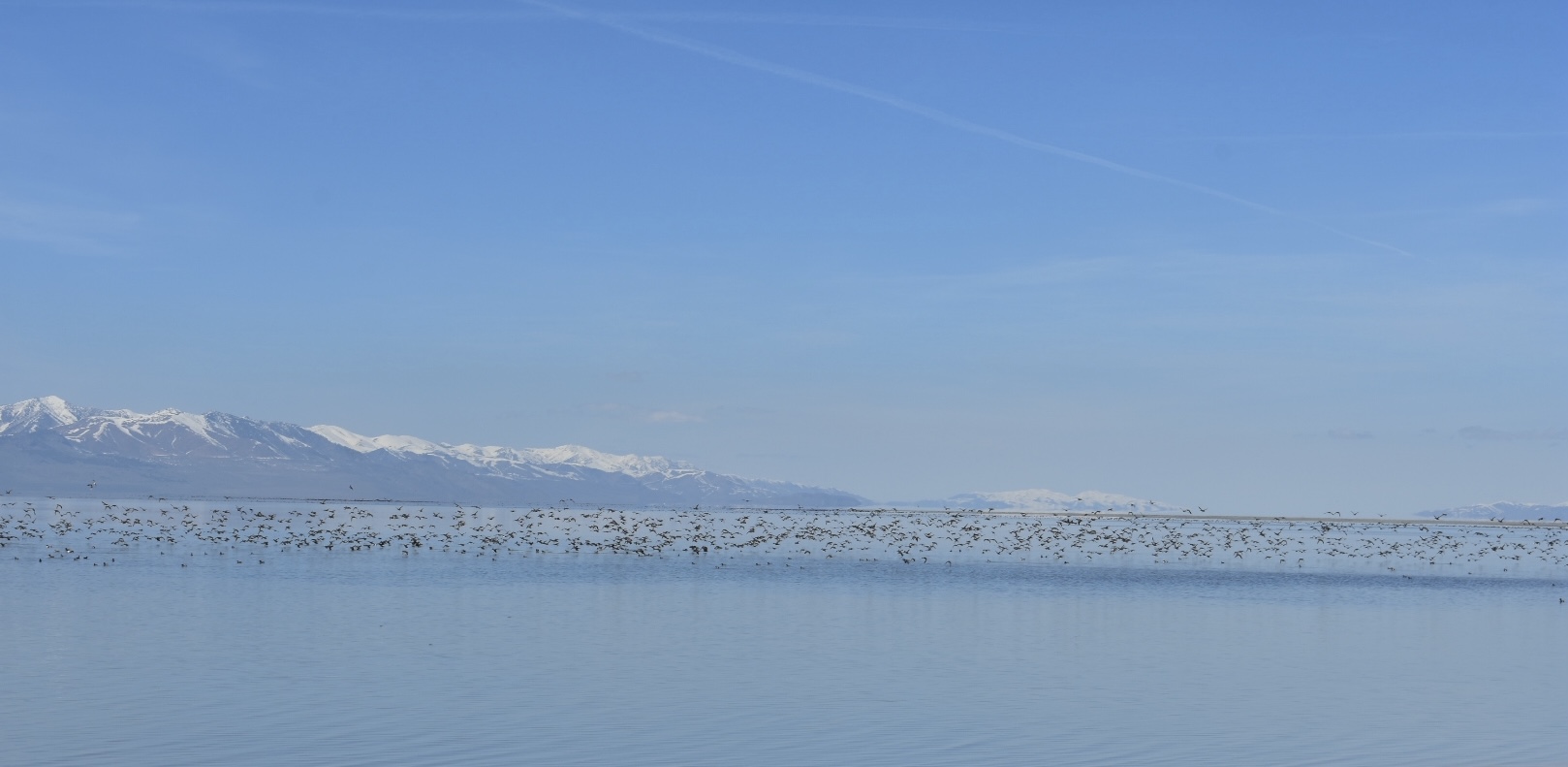
Zoe Exelbert studies birds at the Great Salt Lake. Specifically, she’s interested in how climate change and shifting weather patterns are affecting bird migrations and in turn, how this is impacting the overall ecosystem of Great Salt Lake. Exelbert is a Data Science and environmental studies undergraduate student here at the U. She says understanding the ways these migratory birds are changing their behaviors could be indicative of how we as human are also changing — and may continue to adapt — in response to climate changes. (Feature image courtesy of Zoe Exelbert)
Listen to the Interview:
Transcript:
Ross Chambless
Well, Zoe, welcome.
Zoe Exelbert
Thank you. Thank you so much for having me.
Ross Chambless
So good to see you. I know I’ve been looking forward to talking to you more about your research on Great Salt Lake and bird migration. But to start off with, can you just share a little bit about your background introduction? Who you are?
 Zoe Exelbert
Zoe Exelbert
Hello, everyone. I’m Zoe Exelbert. I’m a junior here at the University of Utah, studying data science and environmental studies. I’m originally from Miami Beach, but I grew up in Colorado for the first seven years of my life, so I had always wanted to come back to the mountains after living in Miami for a while during my college experience and when I came to college, I was very interested in sort of how I could intertwine both data science and environmental studies and sort of use the powers of both of those topics together to, for example, work on research like I’m doing right now, where you can use data science techniques and data visualization techniques to sort of better understand environmental phenomena.
Ross Chambless
Yeah, well, let’s talk about your research right now looking at the Great Salt Lake and you decided to focus on two specific bird species?
Zoe Exelbert
Yeah. So, my research focuses on climate vulnerabilities of the eared grebe and the American white pelican to changes at the Great Salt Lake. And the reasons why I chose these species is that they are pretty good environmental indicators of sort of the state of the Great Salt Lake and how the ecosystem and more specifically the ecological community, how it’s responding to these changes.
And so, the eared grebe is usually seen at the Great Salt Lake. It migrates there from about the spring to the fall time. So, a decent chunk of the year, in numbers from 2 to 5 million birds seen at one time at the Great Salt Lake, which is sometimes their entire continental population. So just given that such a great majority of these species’ continental population is coming to the Great Salt Lake and seen in those numbers every year, we know that this is also a great percentage of all of the species that are coming to the Great Salt Lake.
So, just a bird that was interesting to look at because of their numbers and also their deeply reliant on the brine shrimp population at the Great Salt Lake, which is something that is also predicted and is currently declining as a result of what’s happening there. And then for the American white pelican, they nest at the at Gunnison Island during the spring and summertime, which has shrunken and this sort of perimeter of the lake where land bridges are allowed to form, allowing for increased predation access.
And so, this bird, there’s fossil evidence of the pelicans coming to the Great Salt Lake for over 125,000 years. So just judging that they’re coming to the Great Salt Lake for this great period of time and their land has slowly come to meet the outside of the lake, which is making this an island not really so much an island anymore. Knowing how they’re responding to these changes after having been here for so long, was also why we chose to move forward with studying that species.
Ross Chambless
Right. And just to clarify, when you talk about predation access, essentially, we’re talking about the water surrounding this former island has sort of disappeared and that allows like coyote or other predators just to walk over and eat eggs?
Zoe Exelbert
Yeah. Which could discourage the pelicans from keeping to want nesting there if coyotes keep eating their eggs.
Ross Chambless
Well, so this looks like this sounds like a very interesting way to explore the overall health of the lake’s ecosystem by seeing, you know, how the bird populations are being impacted and how their behaviors are changing.
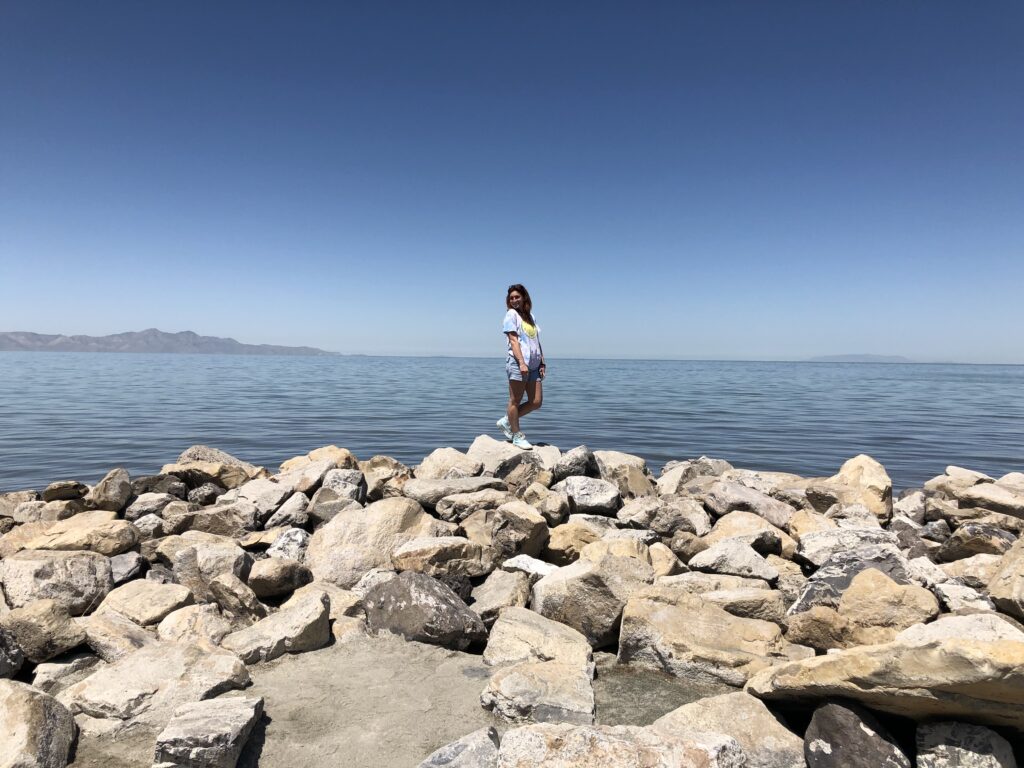
Zoe Exelbert
Exactly.
Ross Chambless
Okay. And so let’s back up a little bit. So why did you decide to focus on this generally? Like, I can see why studying Great Salt Lake, certainly from a local perspective for us living here, is very compelling and there has been a very heightened concern about the lake’s health in recent years. But I guess it seems novel and interesting to look at the birds, the health of the bird populations there, and see how they can sort of be, forgive the pun, but like canaries in the coal mine, kind of telling us, giving us indicators of what the overall ecosystems health might be changing or being impacted.
Zoe Exelbert
So, when I was devising an idea for completing research, when I was applying as a Wilkes scholar about a year ago, I was initially unaware of the amount of birds that come to the Great Salt Lake per year. I was unaware that it was a huge migratory stopover point. Maybe just because I hadn’t lived here long enough and hadn’t looked into it too much. But I wanted to focus on something related to the ecosystem because if you look at the species and the sort of plant species that are living at the Great Salt Lake and are sort of currently seeing or reaping the effects of what’s happening, understanding how they are changing is indicative of maybe how we could respond too.
For example, if these birds are coming to the Great Salt Lake year-round for months on end, how they are responding to what’s happening at the Great Salt Lake, perhaps if they’re becoming discouraged to keep on coming back, what does that mean for humans who are so reliant on water resources from the lake and just our general health as it begins to shrink? Will we begin to respond similar and have to move farther away as a result?
And so, I just think sort of turning the human response away from what’s happening at the Great Salt Lake and looking at these species who have been coming here for perhaps even longer than humans have been civilized around Salt Lake City, near the Great Salt Lake is important for us to sort of turn the tables on. You know, it’s not just us, it’s others as well. And what can we learn from these species?
Ross Chambless
Yeah, that’s a really interesting way of looking at it, sort of seeing how bird behaviors might model or kind of give a prediction of how human populations might behave as well. Yeah, that’s quite interesting. And I know that you have some interesting ways of approaching your research that you mentioned, for example, using citizen science and observations of bird behaviors of the lake. Can you talk a little bit about that?
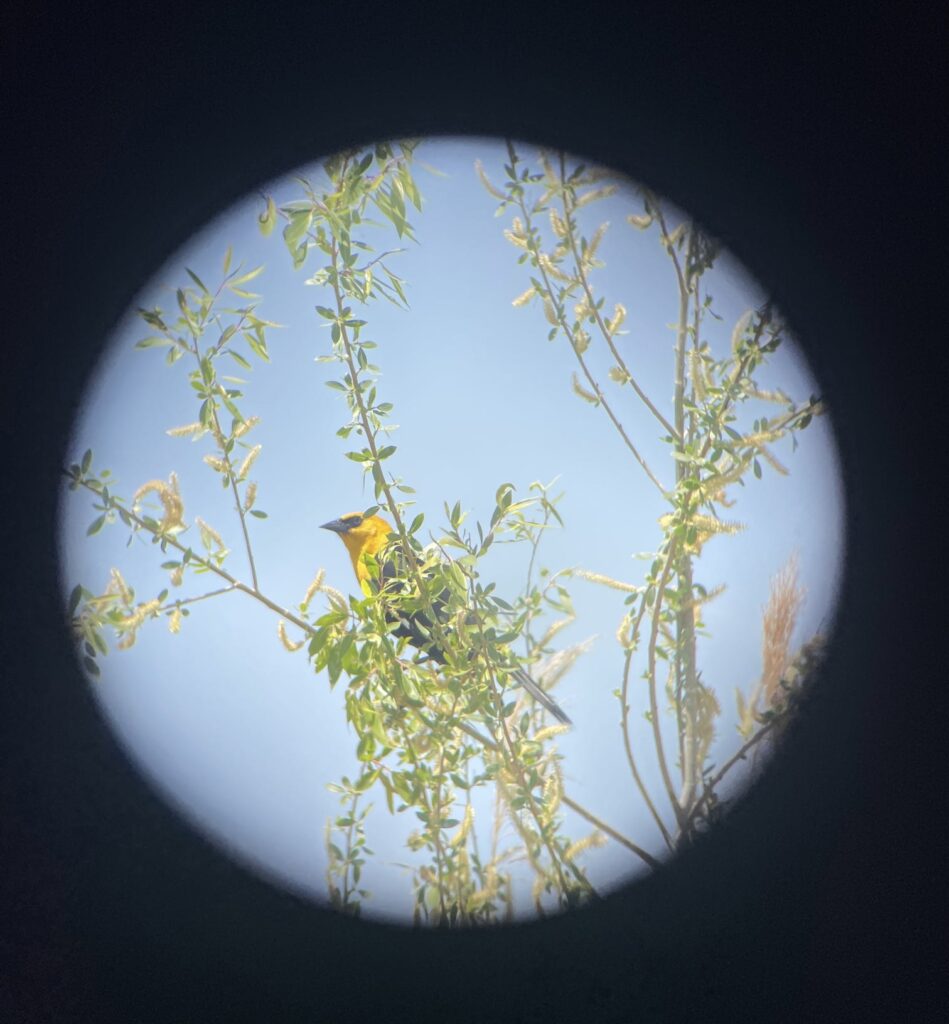
Zoe Exelbert
Yeah. So, the data I use to conduct the our study with pretty much seeing how population distributions are changing at the Great Salt Lake for these two species was accomplished by using data from eBird, which is a citizen science database where basically anyone anywhere can go out and go birding and submit on a checklist on their phone or maybe on their computer. When they go back home, what birds they saw and where. And so, this website has been available since 2004, and it has increased in popularity a lot over the years. And so, it’s just sort of a good database that shows what’s happening to birds as people are going outside and witnessing if they are there or not. And so specifically for the Great Salt Lake, there’s a pretty big birding community there. And in addition to just the large amount of birds that are there as well, knowing that this database has been around for so long and has been available for people to go out and report what birds they’re seeing was good for scientists like me and other scientists to use to sort of see how these populations might be changing.
Ross Chambless
Yeah, it’s an interesting approach. I mean, on one hand, I can see how citizen science does have its pitfalls in some ways because, you know, there might it might be biased as far as certain people wanting to see certain things or choosing to only look at certain sections of the lake perhaps, or only being able to recognize certain types of birds whenever they choose to go out and look for birds. You know, it depends on the timing and lots of factors can influence how that kind of data is collected. But on the other hand, it does seem like an interesting approach to gather such data because it seems it would seem difficult to find any other way to actually track tens of thousands of birds.
Zoe Exelbert
Yeah, I agree. It’s definitely can have more advantages than, say, having to catch a group of 30 pelicans or so and track them over the next 20 years. Not a lot of people have the time to do that. And so, it’s very useful in those cases. If you wanted to just sort of have historical data, what’s already been available by people going out and birding. But yes, it can produce biases of is there actually a biological pattern happening or are there more people birding? So just using proper, for example, data science techniques to sort of scale for this and use the right statistics to represent the distribution of these populations as best as possible is things we have to think about when we were working on this.
Ross Chambless
Right. Well, I want to ask a little bit about more about what your what you’ve been learning through this process and also get your thoughts on one topic as far as the perceptions of what’s happening with Great Salt Lake. Because, certainly you’re tapping into a very hot topic, if you will, as far as there is a lot of interest in great salt Lake right now and certainly by folks who live on the Wasatch Front and concern about what might happen to the lake if if things continue as far as the decreasing water levels and concerns about dust and air quality and all of that. I think that probably trying to wrap our minds around the what’s actually going on with the lake can be a challenge for a lot of folks. I think sometimes there’s this term I’ve been interested in acclimatization where essentially kind of blaming climate change for everything and kind of framing any disastrous environmental event or degraded environmental condition as being caused by climate change.
But, you know, I think when looking more deeply at the issues that are affecting Great Salt Lake, in some ways it transcends climate challenges because the water levels essentially are low because of excessive human diversions and essentially from industry and populations are growing population just taking too much water out of the in flowing streams. And, of course, we’ve had a drought for the last more 20 plus years, although some might argue that the drought and climate change are kind of synonymous.
But I think certainly all of that is affecting bird populations and bird migrations. But I think in some ways it’s important to distinguish those challenges, because certainly the climate change problem has different implications for, you know, just a water diversion problem, because that kind of problem that, if it’s indeed this large problem of humans taking too much water out of the lake and making the lake disappear, that can be more easily addressed or solved as opposed to this sort of daunting, systemic global challenge of climate change, which certainly also plays a role.
So, I’m also just wondering if you’ve been observing this through your research or what your thoughts might be on that?
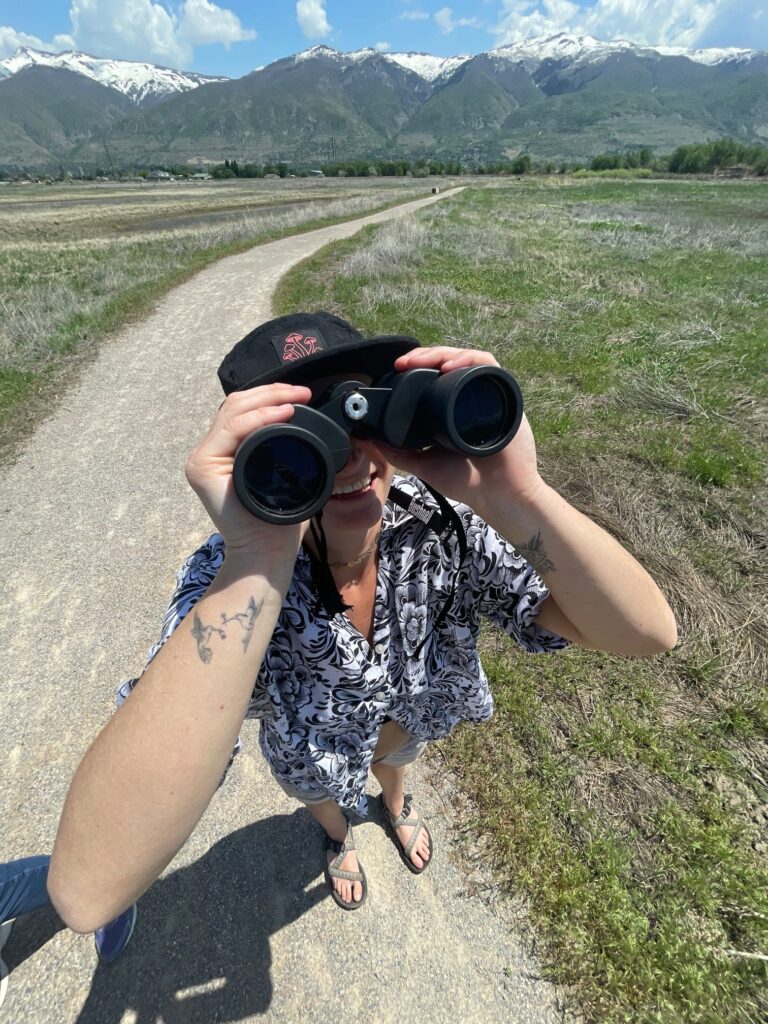
Zoe Exelbert
Yeah, I think you bring up some great points about how climatization changes people’s responses are even willingness to want to hear about certain research that might be done. In my case, I think I have an advantage simply because I’m studying the Great Salt Lake and, you know, I’m doing a climate vulnerability assessment on this area towards bird species. And I think a lot of people, without even having knowing the details of my research, the title alone draws them in because they feel inclined, especially for people who live in the Salt Lake area, to know what’s happening at the Great Salt Lake, because climate change is the only thing affecting the Great Salt Lake and these other reasons why the great Salt Lake might be experiencing these sorts of declines in its health are, yes, as you said, attributed to a lot of human related impacts.
For example, I was asked to speak. There’s a research event through the U at Capitol Hill and your it’s on the legislative session day. And so, I’m supposed to present my research to my legislators in a 2 to 3 minute elevator speech. And so perhaps my research that is about the Great Salt Lake and climate change that my legislators are, of course, more up to date with and someone doing something with cell biology and somewhere else. Maybe they might feel more inclined to understand what I’m talking about because they are more aware of it. Since our community is like we need to learn about climate change at the Great Salt Lake and policy needs to respond more than the fact of understanding how humans are affecting what’s happening at the Great Salt Lake. And is this directly correlated with climate change itself, or is it sort of a separate pathway?
And so, while my research might not get into the details of that, just the topic alone, I think I have an advantage for people wanting to listen. And what they take away from that is up to them. But I have the sort of upper hand, I’d say, in allowing them to learn more about the Great Salt Lake and how birds are responding to it and how climate change is a factor in that. But my hope is that they know that human related impacts that are causing these changes to the Great Salt Lake should not be ignored. And it’s not the only reason that changes at the Great Salt Lake are being seen.
Ross Chambless
Most certainly. And obviously there’s just different ways of getting folks’ attention and making folks aware of certain challenges. Just wanted to ask your thoughts on that. But there is certainly something that you’ve been studying in related to your research and that deals with the impacts to El Nino, the phenomenon of El Nino and how that has been impacting these generational, these evolutionary migration patterns of the birds you’re studying?
Zoe Exelbert
Yeah. So, at the initial stages of our research, sort of to what I explained earlier about why these birds where we chose to see their responses at the Great Salt Lake, we were looking into directly what’s happening at the Great Salt Lake climate wise to effect for the year degree of example, the brown shrimp populations that they’re relying on. And for the American white pelican, the shrinking of the lake, which opens opportunity for predation to increase that affects their nesting success. So, once you sort of identify those key points of what’s happening at the Great Salt Lake, we’re interested in seeing if climate change occurring along their migration route might be increasing these birds’ risk of arriving at the Great Salt Lake in an already vulnerable state and how that might be affecting the vulnerabilities they’re already facing at the Great Salt Lake when they arrive, like decreased Bradshaw populations or more coyotes in pelican nesting habitats.
And so, we were looking at different climate variables such as ocean temperature over their migration range to see if they’re correlated with population counts at the Great Salt Lake. And we did find that ocean temperatures did have a statistically significant correlation with these population counts at the Great Salt Lake, and that changes in ocean temperature are indicative of El Nino and La Nina events.
And so El Nino, what these findings are interesting because climate scientists predict that El Nino specifically is a climate event that will increase in frequency and occurrence as climate change continues. So, when an El Nino event happens, both of these birds overwinter in the Baja, Mexico area before they arrive in the Great Salt Lake in spring. And so, when an El Nino event happens in the ocean side by where they’re migrating, it causes an increase in ocean temperature, so the ocean becomes warmer. And this affects the fish populations that these birds are trying to stock up on for their food supply before making the journey to the Great Salt Lake. And so, what happens to these fish populations when the ocean becomes warmer during an El Nino event is that they their populations either suffer or they migrate elsewhere. And so, these birds were sort of mimic these fish patterns because they’re trying to stock up on this fish supply before having to make the decently long journey to the Great Salt Lake to start breeding and nesting in the springtime.
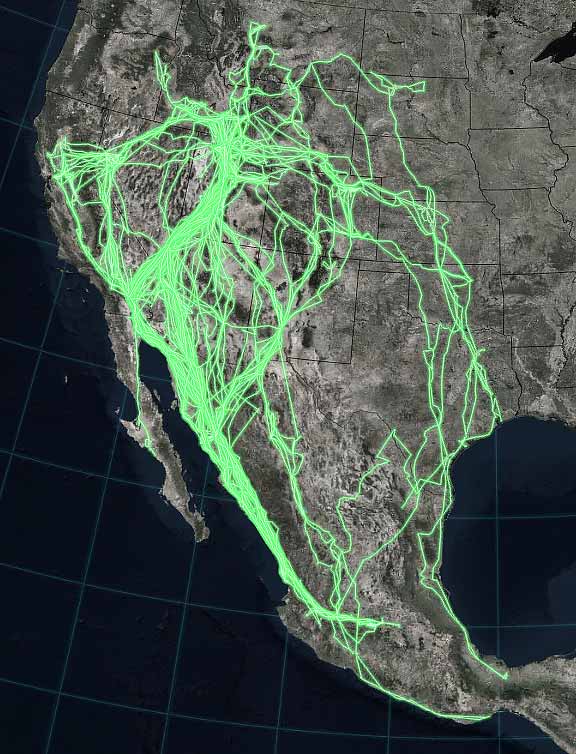
And so, we’re seeing that when this happens, the birds show up in lesser numbers at the Great Salt Lake in the following spring. And this might be because they’re also under environmental stress by having to follow these fish populations that are also potentially decreasing in numbers and migrating elsewhere so that they can be sufficient leaf fed before the Great Salt Lake. But perhaps they’re having to make up for either coming later or not coming at all because they’re not able to get their proper fish supply in this Baja, Mexico area when an El Nino event happens.
Ross Chambless
I see. Yeah, that is quite interesting. So as far as related to that, I mean, my understanding is we’re we’ve been experiencing an El Nino year, maybe we’re still in it, maybe it’s coming, who knows? But and your research is ongoing. So, part of what you’re learning right now is kind of seeing if that plays out and what effects that might have?
Zoe Exelbert
Yeah. And so what’s interesting about these findings is that since we conducted this research over the past 20 years, using data from the past 20 years between 2004 and 2023, because we’ve seen these statistically significant correlations over this time year span, it’s pretty indicative of what can continue to happen in the future if El Nino keeps increasing in frequency and occurrence and bird populations are continuing to follow these declines as a response at the great Salt Lake, then we can make inferences from that that as climate change continues and worsens this event and the Great Salt Lake will worsen in its health as a response, then we know that before the birds even arrive at the Great Salt Lake, they’re probably in a more vulnerable state during an El Nino event. And if they sort of pick up the notion that going to the Great Salt Lake might not help these conditions because of what’s happening at the Great Salt Lake, then this evolutionary response to climate might sort of actually be put into action on the birds and they might sort of shift their migratory routes to better pretty much take care of their survival and respond in a way that is best for their health.
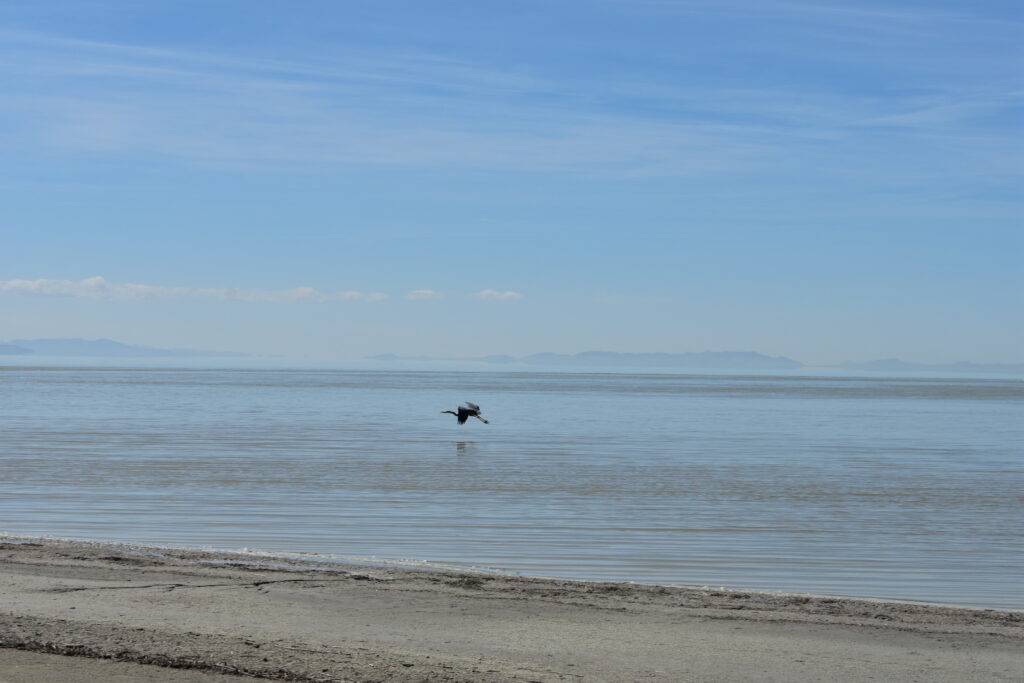
Ross Chambless
Yeah. Wow. Well, that’s really important information that you’re learning. And I mean, it must be tough to dive into this topic and learn so much about the distressing factors influencing these beautiful animals. I didn’t really want to end the conversation that way, but I really wanted to pivot more towards, you know, as challenging as that might be, I imagine that at the same time we’re seeing resiliency at play in some ways. You know, you’re seeing these different these species adapting and also providing, like you said, I love the sort of the image that you mentioned earlier as far as how these the way that these birds behave can set can kind of show us as far as how we might be behaving. We as humans might be behaving also because of these related factors. So, I guess I wanted to ask sort of like what kind of gives you hope or what kind of gives you what keeps you going as far as looking into this research and yeah, what do you find beautiful about? What do you enjoy most about exploring and discovering more about the Great Salt Lake and the birds that inhabit it?
Zoe Exelbert
Yeah, great question. While the results are not super hopeful for the bird populations, I do think you make a good point of that resilience is at play. And birds have been changing their migratory route as an evolutionary response to humans for hundreds of thousands of years.
This is, you know, a sort of old silly example. But when Darwin was studying finches in South America, he noticed that they would change where they were as he continued to study them because they were trying to avoid, you know, humans. And so, while climate change could play a factor in changing these birds’ migratory response, it is sort of their nature to respond to the ways that humans are changing things, nonetheless.
And so, what I think is interesting is that looking at these species that are millions and millions of these birds just in the continent alone and seeing how their responding is a sort of beautiful way to understand like what’s happening at a larger scale.
I think humans tend to sort of home in on themselves a lot and only think about what’s happening to them when climate change is happening. But I think what I enjoy about my research and what I’ve enjoyed talking to people about when I’m talking to them about my research is what they think about it and what they think about these birds and how that sort of could change their perspective on what’s going on. Not even at the Great Salt Lake, but across larger spatial scales of where climate is happening, climate change is happening.
And so I just think it’s sort of a good reminder for people that it’s not just them and it’s other species all across the continent and the globe that are going through the same thing and they are responding to it in the way that they feel best for the pelicans that might be maybe perhaps moving their island nesting habitat at one point, which I just think is a good thing for people to be aware of.
And so, my hope overall is just for positive public and scientific awareness that things are changing at the bird level. And these birds are, you know, they’re very intelligent creatures and they’re also aware of these changes happening because that’s what we’re seeing in these findings and research, you know, going on that here’s a lot of related topics to my research as well. And so, I just think it’s a good thing for people to understand and sort of pivot their direction for. It’s not just me, it’s also them, and how am I affecting them and what are the sort of long-term changes we’re seeing as a result?
Ross Chambless
Yeah, absolutely. Well, that’s a really good way to I think you summarized the main takeaways really well, and I think that’s just a great place to leave it.
So. Zoe Exelbert, thank you.
Zoe Exelbert
Thanks so much. Yeah.
Related Articles